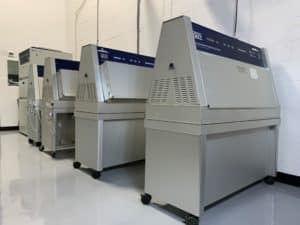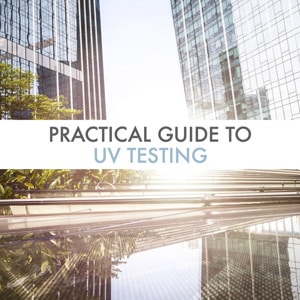ISO 4892
Plastics — Methods of exposure to laboratory light sources — Part 2: Xenon-arc lamps
 Micom offers ISO 4892 sun exposure simulations as part of it offering for UV testing. ISO 4892– Methods of Exposure to Laboratory Light Sources – is a four part standard covering different light sources.
Micom offers ISO 4892 sun exposure simulations as part of it offering for UV testing. ISO 4892– Methods of Exposure to Laboratory Light Sources – is a four part standard covering different light sources.
- Part 1: General guidance
- Part 2: Xenon-arc exposure
- Part 3: Fluorescent UV exposure
- Part 4: Carbon-arc exposure
Exposure to laboratory light sources : use and factors to be considered
 ISO 4892 is the equivalent of the sum of three ASTM standards on accelerated sun weathering:
ISO 4892 is the equivalent of the sum of three ASTM standards on accelerated sun weathering:
Carbon arc exposure is the oldest of the tree exposure types and has lost a lot of popularity since the happening of Fluorescent and Xenon arc exposure as these two uv light sources offer numerous advantages over this older UV simulation.
The equipment required for testing to ISO 4892 both for xenon arc and fluorescent light are fitted with systems simulating the relative spectral irradiance of daylight in the ultraviolet and visible regions of the spectrum for either indoor or outdoor exposure depending on the specific settings. Both methods will expose specimens to various levels of light, heat, relative humidity and water under controlled environmental conditions that need to be defined. Each technique has pros and cons and this should be considered while preparing a test plan.
Typical experimental parameters:
General experimental parameters are as follows:
- Number of specimens per product: 3
- Specimen dimensions: 3” X 6” (for flat specimen)
- Light condition: Indoor or outdoor
Specific experimental parameters:
Learn more about the specific experimental parameters specified for ISO 4892-2 and ISO 4892-3.
Related test methods:
For additional test methods related to ISO 4892 please see: Xenon arc testing and QUV testing.
We also invite you to download our PDF on the true color measurement: What is the difference between the “true” color of an item and its “perceived” color (by the human eye)?
We also invite you to download our brochure to learn more about our Paint, Coating and Polymer testing services.
We also invite you to download our brochure to learn more about our Paint, Coating and Polymer testing services.
Practical UV Testing Guide
Sunlight exposure can have harmful impacts on carbon-based
materials such as coatings, polymers, textiles, and many others.
Learn more about our in-laboratory UV testing process in this guide.


